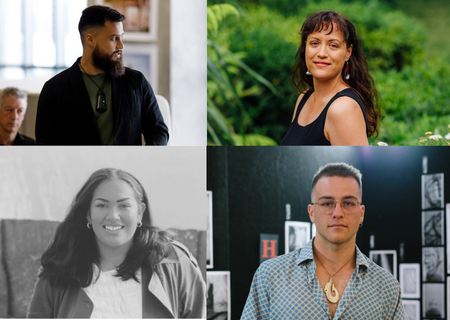Reinforcing presence through architecture and design process.
A panel discussion with Jade Kake, Ben Tunui and T’iafelelea’i Carinnya Feaunati , Chaired by Jahmayne Robin-Middleton.
If the design of our built environment is to be reflective of the communities they serve, where do tangata Māori and Pasifika see themselves in this space?
We saw the development of the Te Aranga Design Principles in 2005 and the signing of Te Kawenata o Rata in 2017.
Te Kawenata o Rata is an institutional covenant that formalises an ongoing relationship of co-operation between Te Kāhu Whaihanga and Ngā Aho (Aotearoa’s Network for Indigenous Design Professionals). With the realising of such kaupapa, how has architectural design practice evolved?
This kōrero is centred around indigenous place-making, and how indigenous practitioners navigate architectural design practice. The discussion more broadly touches on the following:
- Co-design – What even is that?
- How do Architects give meaningful effect to documents such as Te Kawenata o Rata and Te Tiriti o Waitangi?
- Te mana o te reo – The significance of Te Reo Māori, in architectural design practice.
- Design practice that is tika – Designing with respect to Māori rights and rites.
City Talks is an ongoing series initiated by Te Kāhu Whaihanga Wellington Branch and presented in partnership with City Gallery.
The talk will be followed by refreshments.
For those that want to join us from home, see the Facebook event for Livestream details.
Jahmayne Robin-Middleton
Ngāti Kahungunu, Ngāpuhi, Ngāti Rongomaiwahine, Ngāti Tūwharetoa, Ngāti Maniapoto.
Designer at Warren and Mahoney Architects.
A proud 'Kahungunian' from Kohupātiki Marae in Hawkes Bay, Jahmayne is a Designer at Warren and Mahoney Architects, Pōneke. Through his mahi, he has had the opportunity to collaborate with some of Aotearoa's most prominent indigenous creative practitioners. It is through these collabs that Jahmayne finds true purpose in his work. The last few years of his career have seen him work primarily on the new build for Archives New Zealand, a project realised through design partnership with Taranaki Whānui Te Atiawa.
Outside of mahi, Jahmayne is a tauira at Te Wānanga o Aotearoa. He loves a trip to the local driving range, and fills his cup by kicking back with his whānau.
Jade Kake
Nō Ngāpuhi a Jade Kake ki te taha o tōna māmā. Nō Hōrana ia ki te taha o tōna pāpā. Ko ia te kaihautū o Matakohe Hoahoanga me Tōpū Pā, he taupuni hoahoa kei Whangārei. Ko ēnei āna tino kaupapa e aro ana - ko te purenga ihomatua o te hoahoanga me te hoahoa tāone, te whakatū anō i ngā papakāinga Māori, me te whakawhanake i ngā hātepe hoahoa ki te whakamana i te rangatiratanga o ngā hapū. Whakaako hangere ai ia i te kura o Huri Te Ao ki Te Wānanga Aronui o Tāmaki Makaurau.
Jade Kake is from Ngāpuhi, Te Whakatōhea and Te Arawa on her mother's side. She is of Dutch descent through her father. She is the leader and founder of Matakohe Architecture and Urbanism, a design studio in Whangārei. Her main interests are the decolonisation of architecture and urban design, the growth of papakāinga, the re-establishment of papakāinga, and the development of design methods to support the sovereignty of hapū. She is also a part-time lecturer at Huri Te Ao, the School of Future Environments at AUT.
Ben Tunui
Ben Tunui is of Ngāti Awa, Tūhourangi-Wāhiao, Te Atiawa, Hāmoa, Pākehā descent. He graduated from Te Herenga Waka Victoria University of Wellington in 2021 and was awarded the NZIA Student Design Award for his thesis project titled ‘Utu’. The thesis asked the question: How can elements of tikanga Māori be expressed both formally and spatially.
Ben now works at Tennent Brown Architects in Wellington. His mahi in the practice focuses mainly on kaupapa Māori projects from commercial scale to marae revitalization. Alongside working, Ben is on his reo journey with Te Wānanga o Aotearoa, and plans to deepen his knowledge of traditional toi Māori practices. He still expresses an interest in expanding the thinking behind his thesis and how this method could be approached through practice.
T’iafelelea’i Carinnya Feaunati
Carinnya is a New Zealand-born-Samoan from the villages of Fasito’o-uta, Moata’a and Solosolo. Currently based in Pōneke, Wellington New Zealand, Carinnya is a Registered Architect and Cultural Design Lead at Designgroup Stapleton Elliott (DGSE), She holds a tulafale-ali’i chief title of Ti’afelelea’i from her father’s village, Fasito’o-uta. Carinnya’ s work to date has been in the sectors of community, education, transport, and more recently social housing. This work has naturally drawn on her strengths in the cultural design space and co-design with Tangata Whenua and Tangata Moana (Pacific) communities. Working with indigenous communities as clients and project partners has developed a strong advocacy for indigenous rights through care and respect in every stage of the design and construction process.
Outside of practice, Carinnya has an interest in exploring what architecture can do beyond the tangible build. This has led to opportunities to present research on an inter-sector rebuild strategy for the Pacific Islands following natural disasters as well as governance roles as a New Zealand Delegate to the Young Pacific Leaders Forum in Hawaii in 2017 and in Suva, Fiji in 2018. For the last 7 years, Carinnya has worked as a tutor and guest lecturer at Victoria University of Wellington for the 3rd Year Architecture course: Pacific Designed Environments/ Ngā Taiao o Te Moana-nui-a-Kiwa.



